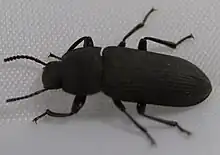Tenebrio obscurus
Tenebrio obscurus, or the dark mealworm beetle, is a species of darkling beetle[1][2][3] whose larvae are known as mini mealworms. These insects should not be confused with younger mealworms (Tenebrio molitor)[4] or with the confused flour beetle (Tribolium confusum).[5]
| Tenebrio obscurus | |
|---|---|
 | |
| Scientific classification | |
| Domain: | Eukaryota |
| Kingdom: | Animalia |
| Phylum: | Arthropoda |
| Class: | Insecta |
| Order: | Coleoptera |
| Infraorder: | Cucujiformia |
| Family: | Tenebrionidae |
| Genus: | Tenebrio |
| Species: | T. obscurus |
| Binomial name | |
| Tenebrio obscurus Fabricius, 1792 | |
Tenebrio obscurus larvae resemble very small mealworms. Larvae are cylindrical and initially white, darkening as they mature. Larvae can reach a length of 25 to 30 millimetres (0.98 to 1.18 in).[6] Larvae then pupate, and later emerge as small, black beetles, 12 to 18 millimetres (0.47 to 0.71 in) long. In appearance, adults are similar to the yellow mealworm. They may have a lighter brown color[6] or appear dull rather than shiny.[7]
Mini mealworm larvae are used as a feeder insect for birds, reptile and amphibian pets, and zoo animals.[8][9] Both Tenebrio obscurus and Tenebrio molitor are being studied for their ability to biodegrade waste polystyrene products. [10][11]
References
- "Tenebrio obscurus Fabricius, 1792". Integrated Taxonomic Information System. Retrieved 4 January 2017.
- Bousquet, Yves; Thomas, Donald B.; Bouchard, Patrice; Smith, Aaron D.; Aalbu, Rolf L.; Johnston, M. Andrew; Jr, Warren E. Steiner (15 January 2018). "Catalogue of Tenebrionidae (Coleoptera) of North America". ZooKeys (728): 1–455. doi:10.3897/zookeys.728.20602. ISSN 1313-2970. PMC 5799738. PMID 29416389.
- Rees, David (21 July 2004). Insects of Stored Products. CSIRO Publishing. pp. 112–113. ISBN 978-0-643-10263-7.
- Dellinger, Theresa A. (February 17, 2023). "Darkling Beetles and Mealworms". Virginia Polytechnic Institute and State University.
- "Tribolium 101: Identifying a Flour Beetle". Tribute to the Tribolium. 20 November 2012. Retrieved 19 September 2023.
- "Dark mealworm". Canadian Grain Commission. Government of Canada. 9 April 2018. Retrieved 19 September 2023.
- "Darkling Beetle". Virginia Cooperative Extension.
- Mariod, Abdalbasit Adam; Mirghani, Mohamed Elwathig Saeed; Hussein, Ismail Hassan (14 April 2017). Unconventional Oilseeds and Oil Sources. Academic Press. ISBN 978-0-12-813433-7.
- Hall, Heidi; Fitches, Elaine; Smith, Rhonda (31 August 2021). Insects as Animal Feed: Novel Ingredients for Use in Pet, Aquaculture and Livestock Diets. CABI. ISBN 978-1-78924-592-9.
- Peng, BY; Su, Y; Chen, Z; Chen, J; Zhou, X; Benbow, ME; Criddle, CS; Wu, WM; Zhang, Y (7 May 2019). "Biodegradation of Polystyrene by Dark ( Tenebrio obscurus) and Yellow ( Tenebrio molitor) Mealworms (Coleoptera: Tenebrionidae)". Environmental Science & Technology. 53 (9): 5256–5265. doi:10.1021/acs.est.8b06963. PMID 30990998. S2CID 119102958.
- Palmer, Kevin J.; Lauder, Kerri; Christopher, Kyeshaun; Guerra, Fatima; Welch, Rebecca; Bertuccio, Alex J. (14 January 2022). "Biodegradation of Expanded Polystyrene by Larval and Adult Stages of Tenebrio molitor with Varying Substrates and Beddings". Environmental Processes. 9 (1): 3. doi:10.1007/s40710-021-00556-6. ISSN 2198-7505. S2CID 245909637.